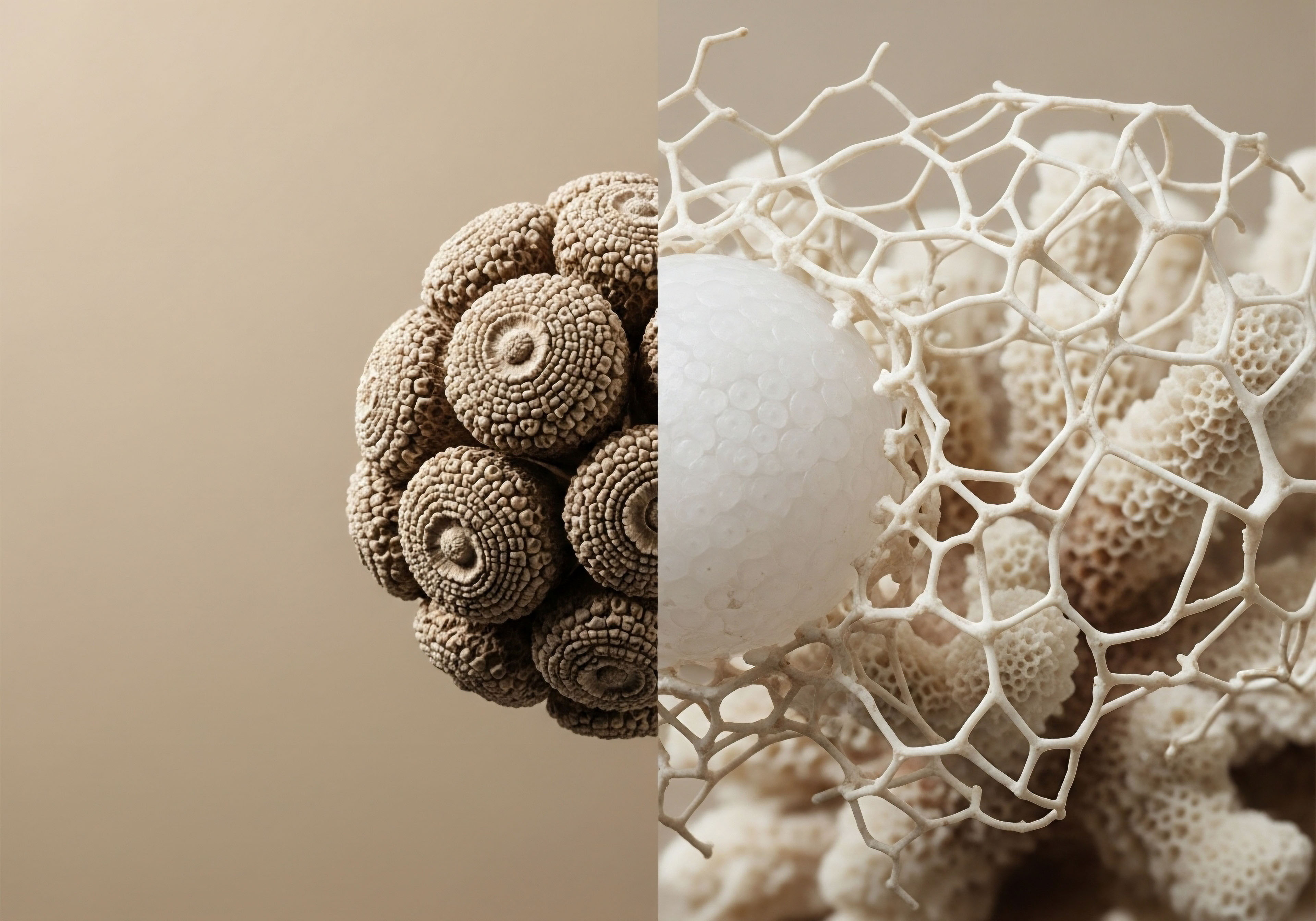

Fundamentals
Many individuals experience a subtle, yet persistent, shift in their well-being as the years progress. Perhaps a diminished drive, a lingering fatigue, or a sense that physical resilience has lessened. These sensations, often dismissed as simply “getting older,” frequently point to more intricate biological shifts occurring within the body’s remarkable internal messaging system ∞ the endocrine network. Understanding these internal communications offers a path toward reclaiming vitality and function.
Testosterone, a vital signaling molecule for both men and women, plays a central role in maintaining energy levels, supporting muscle mass, preserving bone density, and influencing cognitive clarity. When its circulating levels decline, these widespread symptoms can manifest, impacting daily life. Restoring optimal testosterone levels through carefully considered therapeutic protocols can address these concerns.
The administration of testosterone replacement therapy involves various methods, each designed to deliver this essential hormone into the system. These options include topical preparations, regular injections, and subcutaneous pellet implants. Each method presents a distinct pharmacokinetic profile, influencing how the hormone is absorbed, distributed, metabolized, and eliminated by the body.
The choice of delivery system significantly impacts the consistency of hormone levels over time, which in turn influences both symptomatic relief and the potential for systemic effects, including those related to cardiovascular health.
Subcutaneous testosterone pellets, for instance, are small, solid forms of testosterone inserted beneath the skin, typically in the hip area. These implants are designed to release testosterone gradually over several months, offering a sustained delivery. This contrasts with intramuscular injections, which deliver a larger dose at once, leading to higher initial peaks followed by a decline before the next administration.
The differences in these delivery patterns are central to evaluating their respective influences on the body’s systems, particularly the delicate balance of cardiovascular function.
Reclaiming vitality often begins with understanding the body’s intricate endocrine communications.

Understanding Hormonal Decline
The gradual reduction in endogenous hormone production, often termed andropause in men or perimenopause and menopause in women, is a natural biological process. This decline, however, does not signify an inevitable surrender to diminished health. Instead, it signals a need for precise biological recalibration. The symptoms associated with low testosterone, such as reduced libido, decreased muscle strength, increased body fat, and shifts in mood, are direct reflections of the hormone’s widespread influence across various physiological systems.
For women, symptoms can include irregular menstrual cycles, hot flashes, sleep disturbances, and changes in mood, alongside a reduction in sexual desire. These experiences highlight the interconnectedness of the endocrine system, where a shift in one hormonal component can ripple throughout the entire biological network. Addressing these imbalances requires a thoughtful approach, considering the individual’s unique biological landscape and specific needs.

Therapeutic Approaches to Testosterone Optimization
Modern endocrine system support offers several avenues for testosterone optimization. Each method aims to restore circulating testosterone to a physiological range, thereby alleviating symptoms and supporting overall well-being. The selection of a particular method depends on various factors, including patient preference, lifestyle considerations, and the desired pharmacokinetic profile.
- Topical Gels and Creams ∞ Applied daily to the skin, these preparations offer a consistent, albeit sometimes variable, absorption of testosterone. They provide flexibility in dosing but require daily adherence and caution to prevent transference to others.
- Intramuscular Injections ∞ Administered typically weekly or bi-weekly, injections deliver testosterone directly into muscle tissue. This method results in higher peak testosterone levels shortly after injection, followed by a gradual decline until the next dose.
- Subcutaneous Pellets ∞ These small implants, inserted under the skin, provide a continuous, slow release of testosterone over several months. This method offers convenience due to its infrequent administration but limits immediate dose adjustments.
Each of these methods influences the body’s systems differently, particularly concerning the cardiovascular system. The consistency of hormone delivery, the presence of peaks and troughs, and the overall stability of circulating levels are all factors that warrant careful consideration when evaluating the long-term health implications of any testosterone optimization protocol.


Intermediate
The choice of testosterone delivery method holds significant implications for the consistency of circulating hormone levels and, by extension, for the body’s metabolic and cardiovascular systems. Understanding the distinct pharmacokinetic profiles of testosterone pellets versus other methods, such as intramuscular injections, is essential for appreciating their respective influences on systemic health.
Testosterone pellets are designed for sustained release, providing a steady supply of the hormone over a period of three to six months. This continuous delivery aims to avoid the pronounced peaks and troughs often associated with intermittent dosing methods.
The goal is to maintain testosterone levels within a physiological range for an extended duration, which can contribute to consistent symptom relief and a more stable internal environment. However, some clinical observations indicate that pellet therapy can lead to higher peak testosterone levels and may increase the risk of erythrocytosis, a condition characterized by an elevated red blood cell count. This sustained release pattern, while convenient, also means that immediate dose adjustments are not possible once the pellets are implanted.
In contrast, intramuscular injections, typically administered weekly or bi-weekly, introduce a bolus of testosterone into the system. This results in a rapid rise to peak concentrations, followed by a gradual decline until the subsequent injection.
While injections offer flexibility for dose titration, the fluctuating hormone levels can sometimes lead to a cyclical experience of symptoms, with individuals feeling optimal shortly after an injection and experiencing a return of symptoms as levels decline. This variability in circulating testosterone can also influence the body’s physiological responses, including those related to cardiovascular markers.
Pharmacokinetic differences between testosterone delivery methods shape their systemic impact.

Pharmacokinetic Profiles and Systemic Responses
The way testosterone is delivered directly influences its pharmacokinetics, which describes how the body processes the substance. With intramuscular injections, the initial surge in testosterone can lead to a transient supraphysiological state, followed by a period where levels may dip below the desired therapeutic range before the next dose. This oscillatory pattern can affect various physiological processes. For instance, some studies suggest that injections may be associated with a greater risk of erythrocytosis compared to topical preparations.
Pellet therapy, by providing a continuous release, theoretically offers a more stable hormonal milieu. Yet, some research indicates that even with pellets, higher peak levels can occur, potentially contributing to an increased risk of erythrocytosis over time.
Conversely, other studies suggest that injections might lead to significantly higher hemoglobin and hematocrit levels compared to both transdermal gels and subcutaneous pellets, indicating a complex and sometimes contradictory body of evidence regarding erythrocytosis risk across different methods. This highlights the need for careful, individualized monitoring regardless of the chosen delivery system.

Adjunctive Therapies in Testosterone Optimization
Comprehensive testosterone optimization protocols often extend beyond the primary testosterone delivery method, incorporating adjunctive medications to manage potential side effects and support overall endocrine function. These additional agents play a crucial role in maintaining a balanced hormonal environment and mitigating risks.
For men undergoing testosterone replacement, managing the conversion of testosterone to estrogen is a key consideration. Testosterone can be aromatized into estradiol, and elevated estrogen levels can lead to undesirable effects such as gynecomastia or fluid retention. Anastrozole, an aromatase inhibitor, is frequently prescribed to block this conversion, thereby reducing estrogen levels and minimizing these side effects. Typically, Anastrozole is administered as an oral tablet twice weekly, with dosing adjusted based on regular blood work monitoring of estradiol levels.
Maintaining natural testosterone production and fertility is another important aspect, particularly for younger men or those who wish to preserve reproductive potential. Gonadorelin, a gonadotropin-releasing hormone (GnRH) agonist, is often used for this purpose.
Administered via subcutaneous injections, typically twice weekly, Gonadorelin stimulates the pituitary gland to release luteinizing hormone (LH) and follicle-stimulating hormone (FSH), which in turn signal the testes to continue producing testosterone and sperm. This approach helps to prevent testicular atrophy and preserve fertility, which can be suppressed by exogenous testosterone administration alone.
In certain scenarios, particularly for men discontinuing testosterone replacement therapy or those primarily focused on fertility stimulation, other agents like Tamoxifen and Clomid (clomiphene citrate) may be utilized. These medications work through different mechanisms to stimulate endogenous testosterone production, often by modulating the hypothalamic-pituitary-gonadal (HPG) axis. The inclusion of these adjunctive therapies underscores the personalized nature of hormonal optimization, where protocols are tailored to the individual’s specific physiological responses and health objectives.
| Delivery Method | Typical Administration Frequency | Pharmacokinetic Profile | Key Advantages | Considerations |
|---|---|---|---|---|
| Intramuscular Injections | Weekly to bi-weekly | Peaks and troughs | Dose flexibility, rapid symptom improvement | Fluctuating levels, injection site discomfort, potential for erythrocytosis |
| Subcutaneous Pellets | Every 3-6 months | Sustained release, potentially higher peaks | Convenience, consistent long-term levels | Invasive procedure, difficult immediate dose adjustment, potential for erythrocytosis |
| Topical Gels/Creams | Daily | Smoother, more consistent levels | Non-invasive, flexible dosing | Daily adherence, risk of transference, absorption variability |


Academic
The intricate relationship between testosterone and cardiovascular health has been a subject of extensive scientific inquiry. While the overall safety of testosterone replacement therapy (TRT) regarding major adverse cardiovascular events has been largely supported by recent meta-analyses, the specific impact of different delivery methods, particularly testosterone pellets, on cardiovascular stability warrants a deeper physiological and clinical examination.
The question of whether testosterone pellet therapy offers superior cardiovascular stability compared to other methods requires a detailed analysis of pharmacokinetics, systemic effects, and the nuances of clinical trial data.
Testosterone exerts its influence on the cardiovascular system through various mechanisms. It plays a role in regulating endothelial function, the health of the inner lining of blood vessels, which is critical for vascular tone and blood flow. Testosterone can also affect lipid metabolism, influencing levels of cholesterol and triglycerides.
Studies suggest that testosterone optimization may lead to favorable changes in lipid profiles, including reductions in total cholesterol, low-density lipoprotein (LDL) cholesterol, and triglycerides, alongside increases in high-density lipoprotein (HDL) cholesterol. Beyond lipids, testosterone exhibits anti-inflammatory properties, which are relevant given that chronic inflammation contributes significantly to the progression of atherosclerosis, the hardening and narrowing of arteries.
The hormone also has direct effects on myocardial function, as cardiac tissue possesses testosterone receptors, influencing the heart’s pumping efficiency and overall structure.

Pharmacokinetic Profiles and Cardiovascular Markers
The manner in which testosterone is delivered dictates its pharmacokinetic profile, which in turn can influence specific cardiovascular markers. Subcutaneous testosterone pellets provide a continuous, steady release of the hormone over several months. This sustained delivery is often hypothesized to offer a more physiological hormonal environment, avoiding the sharp fluctuations seen with intermittent injections.
However, some data suggest that pellet therapy can result in higher peak testosterone levels shortly after implantation. These higher peaks, while potentially providing robust symptomatic relief, have been implicated in a greater risk of erythrocytosis, an elevation in red blood cell count. Erythrocytosis increases blood viscosity, which could theoretically place additional strain on the cardiovascular system and elevate the risk of thromboembolic events.
Conversely, intramuscular injections, while offering dose flexibility, create a more pulsatile release pattern. The transient supraphysiological peaks and subsequent troughs may also influence cardiovascular parameters. Some studies have indicated a higher incidence of erythrocytosis with injections compared to topical applications.
Yet, other comparative analyses have reported significantly higher hemoglobin and hematocrit levels with injections when compared to both transdermal gels and subcutaneous pellets. This apparent contradiction in the literature underscores the complexity of evaluating erythrocytosis risk across different delivery methods and highlights the need for consistent, rigorous monitoring of hematocrit levels for all individuals undergoing testosterone optimization.
Testosterone’s influence on cardiovascular health is multifaceted, impacting endothelial function, lipid metabolism, and inflammation.

Clinical Evidence and Cardiovascular Outcomes
Recent large-scale randomized controlled trials and meta-analyses have significantly contributed to our understanding of the cardiovascular safety of testosterone replacement therapy. The TRAVERSE study, a landmark trial, investigated the cardiovascular safety of testosterone gel in middle-aged and older men with hypogonadism and pre-existing or high cardiovascular disease risk.
This study concluded that testosterone therapy was non-inferior to placebo regarding the incidence of major adverse cardiovascular events. This finding provides considerable reassurance regarding the overall cardiovascular safety of TRT.
However, the TRAVERSE study also noted a higher incidence of specific adverse events in the testosterone group, including pulmonary embolism, acute kidney injury, and atrial fibrillation. While these findings warrant further investigation and subgroup analysis, they suggest that while overall major adverse events may not increase, certain specific risks might be elevated.
It is important to recognize that these studies often group various testosterone delivery methods, making it challenging to isolate the specific cardiovascular stability profile of pellet therapy versus other forms.
Meta-analyses pooling data from multiple randomized controlled trials generally support the conclusion that testosterone replacement therapy does not increase the risk of major cardiovascular events or all-cause mortality in hypogonadal men. One such analysis, encompassing 30 randomized controlled trials with over 11,500 patients, found no statistically significant differences between TRT and placebo groups for any cardiovascular events, stroke, myocardial infarction, or all-cause mortality.
Another meta-analysis of 26 randomized controlled trials involving nearly 11,000 participants similarly found no statistically significant differences in various clinical outcomes, including myocardial infarction, stroke, congestive heart failure, atrial fibrillation, pulmonary embolism, and venous thrombosis.
Despite these reassuring aggregate findings, the unique pharmacokinetic profile of testosterone pellets, characterized by sustained release and potentially higher peak levels, necessitates ongoing vigilance. The long-term effects of these specific hormonal fluctuations on arterial stiffness, blood pressure regulation, and cardiac remodeling remain areas of active research. While the convenience of pellet therapy is undeniable, the inability to easily adjust dosage once implanted requires careful patient selection and rigorous pre-implantation assessment of cardiovascular risk factors.

Optimizing Cardiovascular Health with Testosterone Optimization
The approach to testosterone optimization must always consider the individual’s complete health profile, including their cardiovascular status. Rather than viewing testosterone therapy as a standalone intervention, it is more accurate to consider it as one component within a broader personalized wellness protocol. This holistic perspective integrates lifestyle factors, nutritional support, and the management of co-existing metabolic conditions.
For individuals considering testosterone pellet therapy, a thorough evaluation of their cardiovascular risk factors is paramount. This includes assessing lipid profiles, blood pressure, glycemic control, and inflammatory markers. Regular monitoring of these parameters, alongside hematocrit levels, is essential throughout the course of therapy.
The goal is to achieve optimal testosterone levels that alleviate symptoms while simultaneously supporting cardiovascular health and minimizing potential risks. The choice of delivery method, whether pellets, injections, or topical applications, should be a collaborative decision between the individual and their healthcare provider, guided by clinical evidence, pharmacokinetic considerations, and personal health objectives.
Rigorous clinical evaluation and ongoing monitoring are essential for optimizing cardiovascular health during testosterone therapy.

Does Pellet Therapy Influence Arterial Stiffness Differently?
Arterial stiffness, a marker of vascular aging and a predictor of cardiovascular events, is influenced by various factors, including hormonal status. While testosterone has been shown to improve endothelial function and potentially reduce arterial stiffness in some contexts, specific comparative data on how different testosterone delivery methods, particularly pellets, influence this parameter are less abundant.
The sustained, steady-state delivery of pellets might theoretically offer a more consistent positive influence on vascular health compared to the fluctuating levels seen with injections. However, the potential for higher peak levels with pellets could also introduce transient effects that require further investigation. Understanding these subtle differences is crucial for a comprehensive assessment of cardiovascular stability.

How Do Pharmacokinetic Peaks and Troughs Affect Cardiac Remodeling?
Cardiac remodeling refers to changes in the heart’s structure and function in response to various stimuli, including hormonal signals. The presence of testosterone receptors in myocardial tissue suggests a direct influence. The pulsatile nature of testosterone delivery via injections, creating distinct peaks and troughs, could potentially lead to different patterns of cardiac adaptation compared to the smoother, more continuous release from pellets.
While the long-term implications of these pharmacokinetic differences on cardiac remodeling are not fully elucidated, it represents an important area for future research to determine if one method offers a more favorable environment for myocardial health over decades of therapy.

References
- Sood, A. et al. “Cardiovascular Outcomes of Hypogonadal Men Receiving Testosterone Replacement Therapy ∞ A Meta-analysis of Randomized Controlled Trials.” European Journal of Pharmaceutical Research, vol. 10, no. 4, 2023, pp. 1-10.
- Lincoff, A. M. et al. “Cardiovascular Safety of Testosterone-Replacement Therapy.” New England Journal of Medicine, vol. 388, no. 17, 2023, pp. 1591-1601.
- Corona, G. et al. “Testosterone and Cardiovascular Risk ∞ Meta-Analysis of Interventional Studies.” Journal of Clinical Endocrinology & Metabolism, vol. 103, no. 11, 2018, pp. 4127-4139.
- Traish, A. M. et al. “Testosterone and the Cardiovascular System ∞ An Update.” Journal of Cardiovascular Pharmacology and Therapeutics, vol. 22, no. 6, 2017, pp. 523-535.
- Dimitrakakis, C. et al. “Testosterone Pellets ∞ A Review of the Evidence.” Maturitas, vol. 104, 2017, pp. 10-15.
- Hackett, G. et al. “Testosterone Replacement Therapy and Cardiovascular Risk.” Trends in Urology & Men’s Health, vol. 10, no. 1, 2019, pp. 18-23.
- Khera, M. et al. “Testosterone Replacement Therapy and Cardiovascular Risk ∞ A Review.” Translational Andrology and Urology, vol. 6, no. 2, 2017, pp. 223-231.
- Morgentaler, A. et al. “Testosterone Therapy and Cardiovascular Risk ∞ A Systematic Review.” Journal of Sexual Medicine, vol. 11, no. 1, 2014, pp. 10-23.
- Bassil, N. et al. “The Benefits and Risks of Testosterone Replacement Therapy ∞ A Review.” Therapeutics and Clinical Risk Management, vol. 5, 2009, pp. 427-448.

Reflection
The exploration of testosterone optimization, particularly concerning methods like pellet therapy and their influence on cardiovascular stability, marks a significant step in understanding your own biological systems. This knowledge is not merely a collection of facts; it represents a powerful tool for personal agency in your health journey. The insights gained about hormonal interplay and the nuances of therapeutic choices can serve as a compass, guiding you toward informed decisions.
Consider this information as a foundation, a starting point for a deeper dialogue with your healthcare provider. Your unique biological blueprint, your individual symptoms, and your personal health aspirations are the most important variables in crafting a protocol that truly resonates with your needs. The path to reclaiming vitality is a collaborative one, requiring both scientific understanding and a profound connection to your lived experience.
The journey toward optimal health is ongoing, characterized by continuous learning and thoughtful adaptation. Armed with a clearer understanding of how hormonal interventions can influence systemic well-being, you are better equipped to advocate for a personalized approach that supports your long-term health objectives. This understanding empowers you to pursue a life of sustained vitality and function, without compromise.



